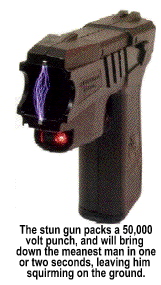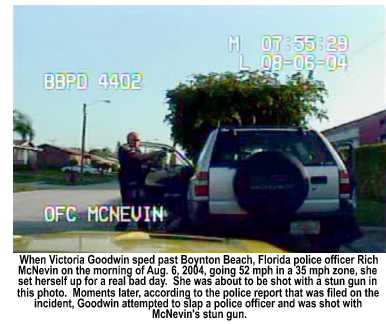
News
Behind the Headlines
Two-Cents Worth
Video of the Week
News Blurbs
Articles
Testimony
Bible Questions
Internet Articles (2015)
Internet Articles (2014)
Internet
Articles (2013)
Internet Articles (2012)
Internet Articles (2011)
Internet Articles (2010)
Internet Articles
(2009)
Internet Articles (2008)
Internet Articles (2007)
Internet Articles (2006)
Internet Articles (2005)
Internet Articles (2004)
Internet Articles (2003)
Internet Articles (2002)
Internet Articles (2001)


![]() f
you are 50-ish, have some minor heart problems, and are prone to
get mouthy at your neighbors or the bartender at your favorite local
pub, you might want to think twice about moving to Florida—the
haven of the elderly. Florida cops have a new toy they use for crowd
control—its called a stun gun, and it packs a terrific wallop.
When they use it, the stun gun can incapacitate a suspect in seconds
and leave him squirming and screaming in the dirt with a sustained
burst.
f
you are 50-ish, have some minor heart problems, and are prone to
get mouthy at your neighbors or the bartender at your favorite local
pub, you might want to think twice about moving to Florida—the
haven of the elderly. Florida cops have a new toy they use for crowd
control—its called a stun gun, and it packs a terrific wallop.
When they use it, the stun gun can incapacitate a suspect in seconds
and leave him squirming and screaming in the dirt with a sustained
burst.
If police are forced to engage in a foot chase, the odds of the suspect being dropped by a blast from a stun gun increases in direct proportion to the shortness of breath experienced by the officer at the end of the foot race. Generally, it won't be an old duffer leading the boys-in-blue over field and dale. It'll be a young buck with more lung capacity than the slightly overweight cop who graduated from the Mr. Donut Police Academy who usually does most of his chasing in a black-and-white and not his dress blues
And even though companies
that make stun guns issue very clear instructions that their product
should never be used on children or the elderly, Florida leads the
nation in the use of stun guns.  The
oldest victim to date? Ninety-five. The youngest? A 6-year old boy.
The most recent? Fifty-six year old Emily Marie Delafield
of Green Cove Springs, Florida who died on April 24, 2006 when police,
who were called to settle a family spat, used a stun gun to subdue
her.
The
oldest victim to date? Ninety-five. The youngest? A 6-year old boy.
The most recent? Fifty-six year old Emily Marie Delafield
of Green Cove Springs, Florida who died on April 24, 2006 when police,
who were called to settle a family spat, used a stun gun to subdue
her.
Delafield, who is wheelchair-bound, was holding a hammer and also purportedly menaced police with a knife. Because she would not put down the weapons, the police subdued her with a stun gun. Delafield lost consciousness and was rushed to Orange Park Medical Center where she was pronounced dead. The Florida State Police are investigating the death. The two officers (who should have known better than to use a stun gun on an infirmed person), were placed on administrative leave pending the outcome of the investigation.
In 2004 the Douglas County (Kansas) Sheriff's Department bought ten stun guns. On Wednesday, April 19, 2006 Sheriff Ken McGovern notified the public that his deputies would start carrying the controversial electro-muscular disruption weapons—almost two years after the county bought the weapons.
Before turning his deputies loose with their new toy, McGovern published the ground rules which he had to know could come back to haunt Douglas County and the city of Lawrence, Kansas if the deputies abused the prescribed "stun gun prerogatives." Using manufacturer guidelines, the deputies would not be allowed to use the stun gun on noticeably pregnant women—unless deadly force is the only other option. They couldn't use them to wake up drunks, or to punish people they've had to chase. Nor would they we allowed to use them on people who are handcuffed, those who are too old—or too young; or those who are physically disabled. If Green Cove Springs, Florida police used McGovern's guidelines, Delafield would still be alive. And, instead of her family arguing with her, they are now arguing among themselves about how much to sue local county government authorities over the death of their dearly departed.
While some Internet "newspapers" report that upwards of 90 people have died as a result of electro-muscular disruption since 2001, in reality, as the Palm Beach (Florida) Post reported, only 70 people in the United States and Canada—61 of them in the United States—have died from positional asphyxia—which critics of the stun gun atrribute to the use of that type of weapon. Industry public relations spinmeisters claim that only 42 people who were shot with stun guns—and that illegal drugs were a factor in 22 of them. Only 5 of those suspects had brandished weapons of any type at the officers who shot them with a stun gun.
When 48-year old Horace Owen broke into the Fort Lauderdale-area West Park home of MacArthur Hodges on June 12, 2005 screaming that someone was trying to kill him, Hodges called the Broward County Sheriff's Department to get the intruder out of his house. Deputies shot the hysterical man—who was high on cocaine—with a stun gun. Owen suffered electro-muscular disruption. He was pronounced dead an hour later at Memorial Regional Hospital in Hollywood, Florida. The coroner ruled his death was the result of a cocaine overdose. Critics claim he suffered a heart attack triggered by the stun gun when the electrical charge affected his heart rhythm. His crime? Doing drugs. Had the Broward County Sheriff's Department used pepper spray on Owen instead of a stun gun, there is little doubt he would have awakened in the hospital or jail the next morning with swollen eyes. But he would have woke up.
The Associated Press reported that forty-seven year old James Borden was arrested because Monroe County, Indiana sheriff's deputies found him wandering around in a drug stupor. At the county lockup, Borden resisted efforts to strip search him. The jailer shot Borden several times in the buttocks with a stun gun. In his own defense, the jailer said: "I asked Borden to lift up his foot to remove his shorts, but he was being combative and refused. I dry-stunned Borden in the lower abdominal area. We got Borden into the booking area. [He] was still combative and uncooperative. I dried [sic] stunned Borden in the buttocks area." After the final shock, the jailer "...noticed that Borden was no longer responsive and his face was discolored." [Excerpt from officer's statement on James Borden.]
The coroner who performed the autopsy on Borden listed three causes of death. He said Borden died of a heart attack due to an enlarged heart; that he was suffering from pharmacological intoxication—and that his death resulted from electrical shock. The jailer was been charged with two counts of felony battery, including battery while armed with a deadly weapon. He could spend the next 16 years in the Indiana State penal system.
Fort Myers, Florida police were called to the Ruth Cooper Center for Behavioral Health Care on Oct. 15, 2005. The Associate Press reported that hospital personnel were struggling with 45-year old Steven Michael Cunningham in the parking lot. A police officer answering the call stunned Cunningham to subdue him where pepper spray may have brought the distraught man to his knees. The former Tennessee man collapsed and later died at Southwest Florida Regional Medical Center. It's unclear what caused the argument in the parking lot. A friend of Cunningham's brought him to the mental health facility because he was acting erratically. Dr. Linda Rush O'Neil of the District 12 coroner's office performed the autopsy. Her report claimed that Cunningham's death was caused by cocaine toxicity and "excited delirium." There is no doubt Cunningham was in an excited state, and that he had taken cocaine. Remove the stun gun from the equation of the likely factors that attributed to his death, and Cunningham would still be alive. Cunningham was stunned three times. The last time, it appears, was after he was subdued and shackled and could harm neither himself nor the officer. It is important to understand, however, that Cunningham's death was not caused by the stun gun. It's too easy to blame a weapon. That's like saying "guns kills people." Guns don't kill people. People kill people. In Cunningham's case—and in the case of every person who has ever died from electro-muscular disruption after being subdued by a stun gun—the problem is not the weapon. Used according to the manufacturer's guidelines, the stun gun is not a lethal weapon. The problem is that if people use the weapon in a manner that violates the manufacturer's protocol for use, an electro-muscular disruption severe enough to cause cardiac distress can occur.
On the same day that Steven Cunningham died, Nov. 26, another Fort Myers resident, 35-year old Tracy Rene Shippy went into a Hallmark Gold Crown store in Page Field Commons on Cleveland Avenue and asked employees to call 911 because she had been in a fight. When police did not respond quick enough to suit her, employees claim Shippy began knocking over store displays. (In all likelihood Shippy, whom Medical Examiner Dr. Barbara Wolf noted was suffering from cocaine toxicity and "excited delirium," may have merely stumbled into the displays and knocked them over.) Nevertheless, store personnel called police to report the unruly customer.
When police finally arrived, according to the Associated Press, one deputy tackled her and handcuffed her. Sgt. Joseph More of the Lee County Sheriff's Dept. stunned Shippy to subdue her. Instead of falling to the floor, she became more agitated and began kicking at the two deputies that were escorting her to the police cruiser for transport to jail. Once inside the car, Shippy tried to kick out the back window of the vehicle. She was shot with a stun gun at least one more time. At that point according to witnesses, Shippy began "foaming at the mouth." There is no public transcript available at this time to show how many times Shippy was stunned or whether or not Shippy merely threw up.
The records show that paramedics were called at 7:08 p.m. Fifteen minutes later Shippy was unresponsive. Her face had turned blue. She was pronounced dead at the Southwest Florida Regional Medical Center shortly after 8 p.m. It should be noted that medical examiners regularly list "excited delirium" as the cause of death in incidents of electro-muscular disruption. Unfortunately, "excited delirium" is not a clinical term and does not represent a medical condition. It is a made-up phrase for a made-up condition that is used to insulate law enforcement agencies from allegations of excessive force, and to absolve them of blame. In manufacturer's memo issued on June 28, 2005 because of the deaths of Cunningham and Shippy on the same day by the same law enforcement agency, the company urged police agencies to revisit their protocol on the proper use of stun guns and "...minimize the uninterrupted duration and total number of...applications." In that memo, the company also told the police that they should use physical intervention along with the stun gun in dealing with people suffering from "excited delirium."
About 3,400 spectators
got a little more than road dust last summer at the annual demolition
derby in Jackson Hole, Wyoming when a male streaker defiantly challenged
authorities by jumping down into the rodeo pit where he grabbed
a fire extinguisher and pretended to spray the audience. Two Jackson
Hole police officers and one sheriff's deputy gave chase. The crowd,
of course, cheered the unidentified streaker. Tired of the foot
race, the deputy sheriff fired his stun gun, hitting the streaker
in the shoulder blade.  The
spectators booed the police as the man stood, shivering for a couple
of seconds as 50,000 volts of electricity coursed through his body
before he fell face down in the dirt, his body twitching from the
high voltage. As the arresting officers grabbed him and pulled him
to his feet, urine trickled down his leg. The scene prompted the
audience to hurl insults and catcalls at the police. A Jackson Hole
Internet reporter surveyed the reaction of the crowd which clearly
disapproved of the police use of a stun gun to subdue a man who
posed no threat to them or anyone else.
The
spectators booed the police as the man stood, shivering for a couple
of seconds as 50,000 volts of electricity coursed through his body
before he fell face down in the dirt, his body twitching from the
high voltage. As the arresting officers grabbed him and pulled him
to his feet, urine trickled down his leg. The scene prompted the
audience to hurl insults and catcalls at the police. A Jackson Hole
Internet reporter surveyed the reaction of the crowd which clearly
disapproved of the police use of a stun gun to subdue a man who
posed no threat to them or anyone else.
Several bystanders questioned what caused the police to act with such violent force on a man who posed no threat—and wondered out loud if a new national violence threshold by police officers had been witnessed. Many wondered if they had witnessed what would befall any citizens who angered police. Most of those present believed the "attack" on the citizen was unwarranted and excessive.
On Sunday, March 6, 2005 Deland, Florida police attempted to arrest a burglary suspect, Willie Michael Towns, 30. Officers Austin Raimundo and Joel Hancock later said Towns had "superhuman strength," and not even pepper spray slowed him down. The officers shot him twice with a stun gun. Towns continued to fight the officers. The third shot brought him to his knees. Towns collapsed. They handcuffed him. For some strange reason, according to the police report, Raimundo and Hancock decided to take their "violent prisoner" to the hospital rather than the lockup. In their report they said that "...enroute to Florida Hospital...[Towns] struggled again and then stopped breathing." He died at the hospital a short time later. Deland police chief Edward J. Overman said he did not believe that the stun gun was responsible for Towns death because, he noted, "...the actual time that he stopped breathing...was maybe 10 minutes away from the...shot." If Towns was not already experiencing some form of cardiac distress they would likely not be taking him to the hospital. They would have taken him to lockup. Whether Towns was stunned again, enroute, to the lockup, is something we will likely never know. In any event, he suffered from electro-muscular disruption and expired.
In June, 2005 William Lomax, 26—who was reportedly high on PCP—got into a scuffle with private security officers at a Las Vegas apartment complex. The police officer responding to the call for help by the security officers shot Lomax seven times with his stun gun. Several of the bursts reportedly happened after Lomax was handcuffed. The doctor who examined the corpse, the Associated Press reported, said the multiple bursts of the stun gun probably prevented Lomax from being able to breathe, and ultimately caused cardiac arrest.
Eddie Alvarado died in 2002 after being shot with a stun gun 5 times by a Los Angeles police officer. In a special report on the death, stun gun company officials officials said that Alvarado died because he had taken cocaine and methamphetamine during a state of "excited delirium." Yulai Wong, the Los Angeles County Deputy Medical Examiner, said the stun gun could not be ruled out as the cause of death since Alvarado actually died from a heart attack.
Gordon Jones was shot with a stun gun 11 times in Orange County, Florida in 2002. He went into cardiac arrest and died. William Anderson, the Deputy Medical Examiner (who is now a private forensic consultant) reported that electro-muscular disruption and cocaine caused his death. "We were looking at positional asphyxia," he said, "[The stun gun] probably got him in that situation." (Positional asphyxia refers to suffocation after being restrained.)
Anderson said it was his opinion that the stun gun very likely made it hard for Jones to breathe. Nine months after Anderson filed his report, county officials requested a second opinion. Dr. Cyril Wecht, a pathologists and lawyer with a national reputation concluded that Jones died from a cocaine overdose. And even though Jones was shot with a stun gun 11 times, Wecht said it did not cause to his death. Anderson still insists it did saying he believes stun guns contributed to the deaths where stun gun electro-muscular disruption occurred and the suspects died. In several of the incidents described here, three or more prolonged bursts with a stun gun might be sufficient to cause tachycardia even in a healthy person.
Currently about 38% of all police forces use stun guns. Last year, stun guns were used about 70 thousand times. Only about 40 people died. If you listen to the police agencies that use stun guns, they will assure you that they are used only on the most violent offenders, or on those who have threatened the law enforcement officers who were dispatched to arrest them. However, the published media history doesn't agree with the rhetoric coming from the law enforcement agencies that use stun guns for anything from subduing violent offenders to crowd control.
The youngest person stunned was a 6-year old boy in Miami who was threatening to cut himself with a piece of glass. Police subdued him with a stun gun. In another Florida incident, a police officer chased down a 12-year old girl who was skipping school. To teach her a lesson, the officer who chased her down in a foot face, subdued her with a stun gun. So far this year, police officers have stunned high school students in Prattville, Wisconsin and Madison, Wisconsin. None of these examples were violent offenders or hardened criminals who posed a physical threat to the police.
The Portland, Oregon Williamette Weekly reported that Oregon police use stun guns on people for nonviolent offenses such as littering, jaywalking or the failure to obey officers. In May, 2004 the Denver Post did an investigative report on the Denver Police Department's use of stun guns to gain compliance from the citizens of Denver—not to subdue violent people. The investigative report indicated that it was not uncommon for Denver police to use the stun gun on handcuffed suspects who simply did not respond to their commands fast enough.
In Rock Hill, South Carolina a police officer used a stun gun to subdue a 75-year old woman whose only crime was becoming distraught when asked to leave a nursing home because she got upset when she couldn't find the room of a sick friend.
In April, 2005 a Minnesota man died after local police shot him with a stun gun because he refused to stop shouting in the middle of a street. That same month a Georgia man died after receiving 3 jolts from a stun gun in a Houston County jail building because he refused to pay a $700 fine. And, that same month in Rockville, Maryland, a man died after being shocked twice with a stun gun. Police were trying to arrest him on assault charges.
A California newspaper reported that a Riviera Beach, California police officer used a stun gun on a derelict he found sleeping on a park bench. Awakened, the homeless man cursed at the officer and refused to stand up and let the cop search him. The unidentified police officer stunned the man twice—once in his leg and once in his shoulder. The derelict was not arrested since he had committed no crime. A Riviera police supervisor told the local media that the officer had been reprimanded for the inappropriate use of force. Note: the officer was not reprimanded for the unauthorized use of force, only the inappropriate use of force.
The Palm Beach Post
reported that a Boynton Beach, Florida officer stopped a man
for riding his bicycle at night without a headlight. When the man
dismounted from the bicycle, he started to run. The officer shot
him with a stun gun and then took him and his bicycle into custody,
believing the bike was stolen.  When
the man proved he owned the bike, the officer released him—and
the bike—after issuing a citation for his riding the bicycle
after dark without a headlight. Pocketing the citation, the man
peddled off into the night—without a headlight.
When
the man proved he owned the bike, the officer released him—and
the bike—after issuing a citation for his riding the bicycle
after dark without a headlight. Pocketing the citation, the man
peddled off into the night—without a headlight.
Victoria Goodwin was shot with a stun gun in Boynton Beach on Aug. 6, 2004 for going 52-mph in a 35-mph zone. Goodwin had just dropped her daughter off at daycare and was heading to her mother's house. She breezed past a yellow Mustang driven by an undercover traffic cop, Rich McNevin, who pulled her over. Things would get worse quickly, and within five minutes, the young mother would be squirming on the ground like somehow having a seizure, whimpering, "Oh, my God, oh, my God." Goodwin was apparently one of those violent suspects that police officers are allowed to use a stun gun to subdue. She was, after all, driving with a suspended license and she did not get our of her Isuzu Rodeo fast enough when McNevin ordered her get out of her car—nor did she get off her cell phone when told to. Another officer with McNevin tried to grab the cell phone out of her hand. At that point, McNevin said in his report, Goodwin tried to slap the other officer and he shot her with his stun gun.
When Antonio Wheeler
was arrested on March 9, 2005 in Orlando, Florida on drug charges,
he was asked to take a urine test because he admitted to have ingested
cocaine. Once at the hospital, Wheeler refused to submit
to the test. Without a court order from a judge authorizing the
forced extraction of urine, police officers ordered Wheeler
handcuffed to the hospital bed and secured with leather straps to
keep him motionless. Wheeler continued to thrash his body making it impossible
for nurses to insert a catheter to get the sample. A police officer
climbed on Wheeler's chest and shot him twice with a stun
gun. After the second shot, the cop put his stun gun against Wheeler's
temple and threatened to shoot him again if he did not cooperate.
Wheeler cooperated. Now he is suing.
Wheeler continued to thrash his body making it impossible
for nurses to insert a catheter to get the sample. A police officer
climbed on Wheeler's chest and shot him twice with a stun
gun. After the second shot, the cop put his stun gun against Wheeler's
temple and threatened to shoot him again if he did not cooperate.
Wheeler cooperated. Now he is suing.
On October 11, Robert
Martinez, a 16-year old Hialeah, Florida youth was shot with
a stun gun by police 7 to 10 times outside a Wendy's.  Martinez
was one of a group of rowdy teenagers who went to Wendy's
after a football game. After causing a commotion, the group was
asked to leave. When they refused, the police were called. But before
law enforcement arrived, the teens left the restaurant. They were
in the parking lot when the police arrived. According to the officer
who shot him with a stun gun, Martinez began kicking and
punching the officers who were sent to clear the parking
lot. According to Martinez's friends, Robert was a
quiet, soft-spoken person who was not causing a problem. Police
shot him with a stun gun, his friends said, because of how he looked,
not for what he was doing.
Martinez
was one of a group of rowdy teenagers who went to Wendy's
after a football game. After causing a commotion, the group was
asked to leave. When they refused, the police were called. But before
law enforcement arrived, the teens left the restaurant. They were
in the parking lot when the police arrived. According to the officer
who shot him with a stun gun, Martinez began kicking and
punching the officers who were sent to clear the parking
lot. According to Martinez's friends, Robert was a
quiet, soft-spoken person who was not causing a problem. Police
shot him with a stun gun, his friends said, because of how he looked,
not for what he was doing.
A 1999 US Department of Justice study on stun guns found that using electro-muscular disruption weapons might cause cardiac distress in people with heart conditions. Every stun gun manufacturer issues guidelines that advise police not to use stun guns on the very young, the aged, women who are pregnant, or people who are disabled. If field officers disregard those guidelines and stun the very young or the very old, tragic consequences may result.
Stun guns are used to stop people who run and force the police to chase them. They are also used, at times, on people who did nothing more than curse at the police officer, spit at them, or people who are verbally abusive. Stun guns are regularly used on people who refuse to willingly put their hands behind them to be handcuffed; or people who are already handcuffed who refuse to get into the squad car for transport to jail. Stun guns, Amnesty International reported, are being used in situations where weapons of force—guns, batons, pepper spray would never be used. Stun guns—which are almost as deadly as automatic sidearms or revolvers—are being used to implement a new legal form of corporal punishment because kidney punching handcuffed suspects is no longer tolerated.
Stun guns are dangerous weapons—particularly when placed in the hands of an angry cop who just chased a smart aleck kid ten blocks and feels like someone just stuck their fist down his throat and ripped out his lungs. Police argue that the stun gun is safe because fewer suspects are shot with regular guns. In Phoenix, police report that a year after issuing stun guns to their patrol officers, police shootings dropped 54%. Scary, isn't it? Give the police something just a little less lethal—but every bit as painful—and they will kill fewer citizens. Sure glad I don't live in Phoenix.

Copyright © 2009 Jon Christian Ryter.
All rights reserved.


